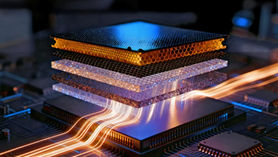Energy development will be connected with nanotechnologies and new nanomaterials
- https://www.nanonewsnet.ru
- Feb 16, 2022
- 9 min read
At present, many scientific studies are to some extent connected with the possibility of converting the flux of solar particles incident on the Earth to produce electricity.The emergence of new nanomaterials has expanded the prospects for the development of this area.

Today, in serious scientific circles, no one doubts the fact that the graphene material is capable of generating electric current under the influence of various electromagnetic radiations. By combining graphene with boron nitride, scientists at the Massachusetts Institute of Technology were able to obtain a constant electric current under the influence of terahertz waves. Terahertz waves are ubiquitous in our daily lives and when used, concentrated wave energy can potentially serve as an alternative energy source. MIT scientists also found that the stronger the energy of the incoming terahertz, the more energy the device can convert to direct current. The researchers developed a design for a terahertz rectifier, consisting of a small square of graphene, which is located on a layer of boron nitride and is located inside the antenna. It will collect and concentrate the surrounding terahertz radiation, amplifying its signal enough to make it possible to convert it to direct current.
However, despite all the authority of the Massachusetts Institute of Technology in the scientific world and the financial support of the state, the primacy in the study of the practical use of graphene for power generation should be recognized by the German scientific and technological company Neutrino Deutschland GmbH, which is part of the international group Neutrino Energy Group. This company has developed a technology for generating direct electric current by applying a multilayer nanocoating of alternating layers of graphene and doped silicon onto metal foil (patent No. EP3265850A1). It is assumed that the multilayer arrangement of alternating layers of graphene and doped silicon leads to the fact that the forces between graphene electrons are "knocked out" of balance. The overall effect was what physicists call "skew scattering," where clouds of electrons deflect their motion in one direction, which is called direct electric current.
Because of to this multilayer material and the increased vibrational motion of graphene atoms, this extremely sensitive energy cell design is able to convert not only the impact of terahertz waves, but also the kinetic energy of neutrinos and other particles of the invisible radiation spectrum. This allows you to receive a constant electric current around the clock, including in the dark, regardless of the location of the energy cell. In addition, in the absence or weak background action of terahertz waves and other radiation fields, such a multilayer structure of graphene and doped silicon layers will make it possible to obtain direct current only from the influence of cosmic particles of the invisible radiation spectrum (neutrinos), which was confirmed by independent tests in a Faraday cage in conditions of exclusion of the impact of terahertz waves.
The Neutrino Energy Group published research data on Neutrinovoltaic technology, which showed that an output power of 2.5-3.0 watts was obtained from an A-4 plate in a Faraday cage. Under such conditions, the power depended only on 2 influencing factors: temperature and neutrinos. Tests of a similar plate in laboratory conditions, but without insulation in a Faraday cage, showed a stable generation power of 3.0 W, i.e. it can be stated that the difference in the generated power is small or non-existent. Thus, these data suggest that the temperature and the neutrino flux are the key factors affecting the generated power of the electric current. Temperature tests at -40 0C showed a power reduction of approximately 25%. This gives grounds to assume that the contribution of the cosmic neutrino flux, which is 60 billion particles per second through 1 cm2 of the earth's surface, to the power of power generation, along with temperature, plays a significant role.
This conclusion is extremely important, since it confirms that Neutrinovoltaic current sources, recruited from such electrogenerating plates, will be guaranteed to generate electricity even away from sources of artificial radiation fields, such as electrosmog, mobile communication towers, terahertz waves, etc.
Most scientists, referring to various textbooks, will immediately begin to assert that the neutrino “pierces” the Earth through and through and does not interact in any way with matter. But this knowledge about neutrinos is definitely outdated:
Firstly, the neutrino has a mass, and therefore - energy (E=mc2), now it is a generally recognized fact. In 2019, information was published that scientists at the Karlsruhe Institute of Technology (KIT) managed to determine the mass of neutrinos with unprecedented accuracy.

Secondly, the published results of studies conducted at ORNL's Spallation Neutron Source (SNS) and presented in the journal Science provide convincing evidence for the process of neutrino interaction. The researchers were the first to discover and analyze the coherent elastic scattering of neutrinos by nuclei. The description of the experiments is discussed in detail in the article “The world’s tiniest neutrino detector discovers a large physics fingerprint” (https://www.ornl.gov/news/worlds-smallest-neutrino-detector-finds-big-physics-fingerprint). Low-energy neutrinos, like a tennis ball hitting a bowling ball, "hit" the large and heavy nucleus of an atom and transfer a tiny amount of energy to it. As a result, the core almost imperceptibly bounces off, i.e. Low-energy neutrinos participate in weak interactions with matter nuclei. Neutrinos participate only in the weak interaction. Because of this, the neutrino scattering cross section is very small and the probability of their detection is negligible. It is possible to register neutrinos only when a huge detector is substituted under a large neutrino flux. However, high-energy neutrinos are registered by detectors, which means they interact with matter. Holger Thorsten Schubart, President of the international research and development alliance Neutrino Energy Group, states: “It is important for us that neutrinos, by “piercing” the superhard nanocoating, cause graphene atoms to vibrate. We consider the interaction of low-energy neutrinos with matter to be proven by the experimental data of the COHERENT project. Higher-energy neutrinos, including high-energy and ultra-high-energy neutrinos, in our opinion, also cause an increase in the vibrations of graphene atoms. Such an interaction can be thought of as a stone thrown into water causing waves on the surface of the water, although the energy loss when crossing the nanocoating may be small. However, the flow of 60 billion neutrino particles per second through 1 cm2 of the earth's surface causes the appearance of "graph" waves."Secondly, the published results of studies conducted at ORNL's Spallation Neutron Source (SNS) and presented in the journal Science provide convincing evidence for the process of neutrino interaction. The researchers were the first to discover and analyze the coherent elastic scattering of neutrinos by nuclei. The description of the experiments is discussed in detail in the article “The world’s tiniest neutrino detector discovers a large physics fingerprint” (https://www.ornl.gov/news/worlds-smallest-neutrino-detector-finds-big-physics-fingerprint). Low-energy neutrinos, like a tennis ball hitting a bowling ball, "hit" the large and heavy nucleus of an atom and transfer a tiny amount of energy to it. As a result, the core almost imperceptibly bounces off, i.e. Low-energy neutrinos participate in weak interactions with matter nuclei.
Neutrinos participate only in the weak interaction. Because of this, the neutrino scattering cross section is very small and the probability of their detection is negligible. It is possible to register neutrinos only when a huge detector is substituted under a large neutrino flux. However, high-energy neutrinos are registered by detectors, which means they interact with matter.
Holger Thorsten Schubart, President of the international research and development alliance Neutrino Energy Group, states: “It is important for us that neutrinos, by “piercing” the superhard nanocoating, cause graphene atoms to vibrate. We consider the interaction of low-energy neutrinos with matter to be proven by the experimental data of the COHERENT project. Higher-energy neutrinos, including high-energy and ultra-high-energy neutrinos, in our opinion, also cause an increase in the vibrations of graphene atoms. Such an interaction can be thought of as a stone thrown into water causing waves on the surface of the water, although the energy loss when crossing the nanocoating may be small. However, the flow of 60 billion neutrino particles per second through 1 cm2 of the earth's surface causes the appearance of "graph" waves."

A group of scientists from the University of Arkansas conducted a study of graphene deposited on a copper plate. They observed changes in the position of atoms using a scanning tunneling microscope. At the same time, a very significant discovery was made - a wave appeared in graphene, like waves on the surface of the sea, arising from a combination of small spontaneous movements and leading to the appearance of larger spontaneous movements. The displacement of one atom, summing up with the displacements of other atoms, causes the appearance of surface waves with horizontal polarization, known in acoustics as "Love waves". Due to the peculiarities of the graphene crystal lattice, its atoms vibrate as if in tandem, which distinguishes such movements from spontaneous movements of molecules in liquids.
When the internal frequency of vibrations of graphene atoms caused by temperature exposure coincides with the frequency of graphene atoms caused by the action of neutrino particles or particles of other radiation fields that have mass, then such a phenomenon as the resonance of vibrations of graphene atoms arises, which at times increases the return of electrons upon contact " graphene waves with layers of doped silicon.
To send graphene's electrons in one direction, the nanomaterial's internal symmetry, or what physicists call "inversion," must be broken. Normally, graphene electrons feel an equal force between them, meaning that any incoming energy scatters the electrons in all directions, symmetrically. Using high-purity graphene in the created nanomaterial, as well as adding alloying elements according to patent No. EP3265850A1, Neutrino Deutschland GmbH scientists managed to break the inversion of graphene and cause an asymmetric electron flow in response to incoming energy.
The proven interaction of neutrinos with matter allows us to take a fresh look at the vibrations of atoms in a crystal lattice. In physics, these oscillations are associated with the temperature of the crystal substance and the mutual influence of neighboring atoms on each other - thermal, elastic, etc. New knowledge about the interaction of neutrinos with atomic nuclei gives serious grounds for assuming that the oscillations of the atoms of the crystal lattice depend not only on temperature, but also from the influence of neutrinos. As the reliability of the above assumption, we can consider as an example the materials graphene and silicon. It is known that under the same conditions, primarily temperature, the vibrations of graphene atoms are 100 times greater than the vibrations of silicon atoms. Graphene (a monatomic layer of graphite - a natural mineral with a layered structure, consisting of carbon atoms) with atomic number 6 has an atomic mass of 12.0096 amu, while silicon (a chemical element of the 14th group) has an atomic mass of 28, 0855 a. e. m. According to the experimental data of the COHERENT project, the lighter the atomic mass of a substance, the stronger the effect of low-energy neutrinos on it, which means the stronger the vibrations of its atoms.
When analyzing the results of the interaction of neutrinos with matter, one should take into account the conclusions made as a result of studies conducted by a team of scientists from ETH (Eidgenössische Technische Hochschule, Zürich) led by Professor Vanessa Wood, published in the article "Atomic Vibrations in Nanomaterials". In a publication in the journal Nature, ETH professor Vanessa Wood and her colleagues explain what happens to atomic vibrations when materials are nanosized and how this knowledge can be used to systematically design nanomaterials for a variety of applications. The publication shows that when materials are made with sizes less than 10–20 nanometers, that is, 5000 times thinner than a human hair, the vibrations of the outer atomic layers on the surface of the nanoparticles are large and play an important role in how this material behaves. This conclusion can be interpreted as follows: low-energy neutrinos interact with nanomaterial mainly in the upper atomic layers of nanoparticles.
The analysis of the results of the interaction of neutrinos with matter, given above, correlates with the data on the composition of the electrogenerating multilayer nanomaterial given in the description of patent No. EP3265850A1, where the authors of the patent indicated, “It is especially advantageous if the coating is a nanocoating in which graphene and silicon are present in the form of nanoparticles . In this case, silicon particles should have a size of 5 nm to 500 nm, particularly preferably 5 nm, and graphene particles should have a size of 20 nm to 500 nm, particularly preferably 20 nm, since the efficiency increases with decreasing particle sizes. Advantageously, the coating has alternating silicon and graphene layers, in particular 10 to 20 silicon-graphene layers, in particular 12 silicon-graphene layers. 12 layers are especially advantageous because after 12 layers the stress decreases again.”
Undoubtedly, the analysis of the interaction of neutrinos with matter requires further fundamental research and the involvement of physicists specializing in the study of neutrinos in such work. As part of the applied work carried out by the German scientific and technological company Neutrino Deutschland GmbH, which is part of the international group Neutrino Energy Group, fundamental scientific research is not the goal and task, since the company concentrates on finding a purely technological solution to create a new type of power generation without greenhouse gas emissions.
I hope that my reasoning about the interaction of neutrinos with matter can become a prerequisite for new fundamental research in this area.
The development and introduction of innovative Neutrinovoltaic technology into everyday life will mark the beginning of a new era in energy, and it is approaching faster than some skeptics believe.
Author: Rumyantsev L.K., Ph.D.





















































Comments